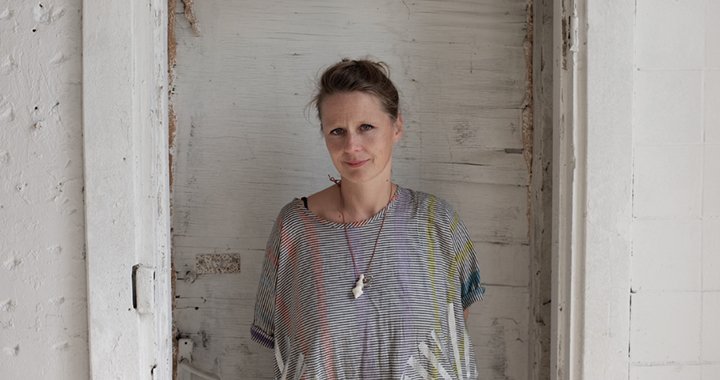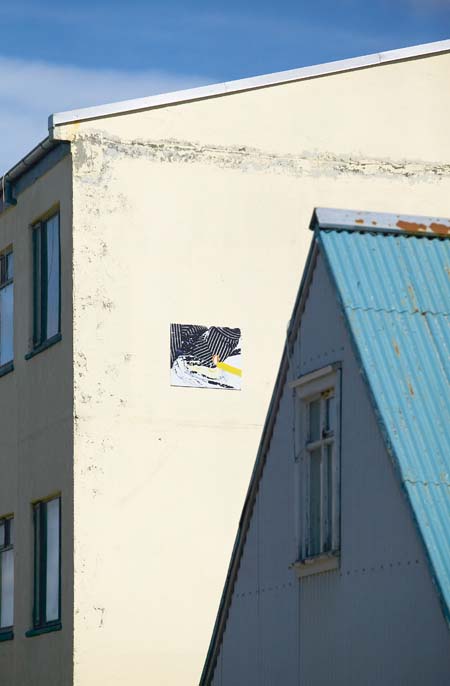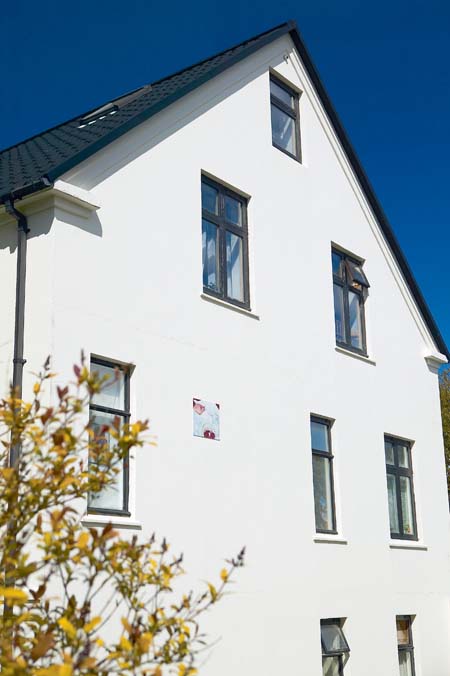
Like a Barometer In a Room
An Interview with Icelandic Artist Margrét H. Blöndal
05/09/2015
At the Cēsis Art Festival that took place in Latvia right in the middle of this past summer, Icelandic artist Margrét H. Blöndal (1970) presented her work Untitled (rubber, thread, fillings, weight, holes, sticks, cloth, pink, soot, stitches, blue, yellow and glue). Displayed in the central venue for Festival exhibitions, the Cēsis Beer Brewery, this laconic and minimalistic piece brought to prominence the exhibition hall's physical character and textural surfaces that, up till then, had been masked behind a whitewash of paint. It seemed as if Blöndal's fragile objects had come into being all by themselves in the room, and that they had always been there; when imagining the space without them, the room becomes, in a sense, muted and subdued.
It was important for the artist that she could create the work in an authentic room of the old brewery, one that was filled with light and free of any artificial dividing panels of the type usually used in exhibitions. Blöndal created the work on site over a period of two weeks, much like she did in 2008, at the European art biennial Manifesta 7, which took place in Trentino, Italy that year. Trentino is a small city, as is Cēsis, and back then Blöndal also had two weeks in which to create her piece. When asked about her participation in Manifesta 7, Blöndal replies that she doesn't view it as a special achievement: “It was simply a good experience to go through. I just continued to go down the road that I had already started on.”
Margrét H. Blöndal's work is always about being present, about being in a certain place at a certain time, and about the chance to take in what is going on around oneself. Blöndal admits that the creation of the work is the work itself; this encompasses the study of the space and the surrounding environment, the hunting down of materials, and the search for solutions to complex problems, as well as the amplitude of emotions that accompanies these actions.

Margrét H. Blöndal. Untitled (rubber, thread, fillings, weight, holes, sticks, cloth, pink, soot, stitches, blue, yellow and glue), 2015. Cēsis Art Festival
What was your starting point in the conceptualization of this work?
The first time I entered this room, the numerous architectural details of the space drew my attention. The cracks and holes in the walls, the rough and uneven floor, the stairs, the large windows, the bricks, rocks and wood... There is so much information in these walls, and I wanted to activate all of it. It was important to me that the work becomes a part of the space, and to draw the viewer's attention to its details and the room as a whole. One could imagine that these works have always been here, but at the same time, by just snipping a few strings, it can all be removed as if it had never been here. And if you do that, these objects don't look like anything – without the space, they are nothing.
What happens within you, on an emotional level, when you come face to face with the challenge of a new room, a new space?
I'm like a barometer in a room. I'm like an animal that acts only in response to its feelings and reacts accordingly. You must understand that it's more like a physical reaction – it's nothing conceptual, there's nothing intellectual about it.

Margrét H. Blöndal. Teeming I, at the art biennial Manifesta 7
So, before starting a work, you usually don't try to find out the building's or the space's historical context? Would you say that these aspects don't have much meaning in your creative process?
In this case, the fact that the building used to be a beer brewery is probably less important than the fact that it was built a century and a half ago. The building in which I stayed while I was working on this piece is also old. It was once part of a manor compound; then it was used as a tuberculosis hospital, and now it houses an artist residency center. Just as important are the various feelings that arise from the city's historical associations as a whole. It is all linked to my experiences and feelings here, in Cēsis, as a whole. However, if I were to try to emphasize some certain historical aspects through my work, I would be trying to be much too clever, and the work would no longer be interesting.
I'm simply using what the space gives me. I've used those hooks in the ceiling and the many holes in the walls – I thought about how I could make them a part of my work. When entering the room and just quickly glancing around, it could seem that there is nothing there. But there is something there, and it requires one to take some time to notice all of it.

Margrét H. Blöndal. Untitled (rubber, thread, fillings, weight, holes, sticks, cloth, pink, soot, stitches, blue, yellow and glue), 2015. Cēsis Art Festival
You tend to make your works from very simple, everyday items and materials. Could you tell us how you chose the materials for this piece?
I had taken very little materials along with me. Just some strings, a piece of fabric... Some of the things that I have been collecting from the streets of Iceland for years now. Here is some debris from New Year's fireworks, a festival bag... But that's not enough. Every time I create a work, I always feel like an animal – an animal that is constantly sniffing around things. I look around and try to find things. That's how right here, on site, I found some rods; I asked around for some old furniture; then I combed the shops – used clothing stores, toy stores and book stores, fishing tackle shops... I looked for things that I could see as having some potential for being used in my work.
Since my work time here coincided with the Midsummer Festival, the shops were closed for a few days. I was in such need of fabric that I cut up my cloth bag with the Sequences Art Festival logo on it. I am so very fond of these situations in which there is nothing left to do but use what you have on hand at the moment, and find the potential in it. My work is also about having to go on; you must find a way! I have been given this space, and for a discrete amount of time, it becomes my world. You must live with this world and you must answer to it. It is my field, and I must deal with it.

Margrét H. Blöndal. Untitled (rubber, thread, fillings, weight, holes, sticks, cloth, pink, soot, stitches, blue, yellow and glue), 2015. Cēsis Art Festival
There have been times when I've found excellent materials; I spent two days cutting it, bending it, pinning it – and in the end, I realized that it will simply not fit into the work. That happened this time as well. I got rid of it, and with no regrets. Maybe I'll use it some other time. For instance, this blue and white fabric – I found it in Rome, in 2007, I think. It took me a long time to find a use for it, but now I finally have.
How can you tell that something isn't right – that something doesn't fit it, or that something is missing? How do you know when your work is done?
That's interesting... When I'm working, I become physically very sensitive. If something isn't the way it should be, my whole body tenses up and I just know that something's wrong!
Things constantly change during the working process – something is pulled in, or cut out, and suddenly everything comes into place as if on its own. In this case, when working on this last object [a blue sculpture made from a toy], I knew it would have to be on the floor, but I didn't know that it would be so low. Actually, it's only a part of another, much more complicated structure, but I suddenly felt that the object must be placed right here and just like this. When I did that, all of the objects instantly clicked into place with one another.

Margrét H. Blöndal. Untitled (rubber, thread, fillings, weight, holes, sticks, cloth, pink, soot, stitches, blue, yellow and glue), 2015. Cēsis Art Festival
Could it be said that this is the central object of the work?
Perhaps it's the first thing that draws one's attention, but then a much wider scene opens up. You see those blue blotches on the floor? They were already there. And this object simply draws one's attention to them, thereby slowly revealing the space and what it carries within it.
What will happen to this work after the Festival?
As I already mentioned, my sculptures are created as a physical answer to a specific environment. However, once they have been created, they can also exist outside this environment. Nevertheless, they communicate with one another most effectively in the place where they were created – like the stars in the Universe's galactic systems. But, of course, some pieces I could apply to different rooms. Some of the sculptures can take on a different form depending on how they are placed by the wall.

Margrét H. Blöndal. Teeming I, at the art biennial Manifesta 7
Should we regard each piece that you create as something completely new, or are you, in some way, continuing with something ongoing?
My method of working is one and the same, because I am one and the same person. If I begin to repeat myself, it is no longer interesting for me. However, it is possible that some similarities can be seen among the works. For example, this little thing made from a toy – it reminds me of something I've done before. But that was a long time ago. And I didn't consciously repeat it. It definitely is not the same interpretation.

From Margrét H. Blöndal's notebook. The title of the piece: Untitled (rubber, thread, fillings, weight, holes, sticks, cloth, pink, soot, stitches, blue, yellow and glue), 2015.
This piece is titled: Untitled (rubber, thread, fillings, weight, holes, sticks, cloth, pink, soot, stitches, blue, yellow and glue), 2015. It's quite peculiar. How would you explain it?
Occasionally, to keep to some sort of guideline, I need to title a piece first. I didn't do that for this piece, however. In this case I gave it a name after it was finished. This title indicates that the work is a union of various forces and materials (for me, colors are also a material).

Margrét H. Blöndal. Untitled (rubber, thread, fillings, weight, holes, sticks, cloth, pink, soot, stitches, blue, yellow and glue), 2015. Cēsis Art Festival
Do you think with words, or with images?
There are two worlds – one is the world of visions, a world that lacks words and labels; it is more about feelings and experiences. Then, of course, there is the other one – the world of thoughts that can be clothed in words. I don't think with words, but words are important to me – through them I can focus my thoughts. And it is important for me to write down my thoughts. But I don't tend to sketch out conceptual expositions or write finished work descriptions; I'd rather prefer the public to come up with their own opinion, so there is room for a dialog. In addition, you can never control the viewer's experience. Some people have patience, some don't. However, if people take the time, this usually comes with its rewards. When you give yourself time, some sensation might enter you for example, about this stick... Does it suggest some movement? Is it a cane for supporting oneself? Reflections may not come to you immediately, but something might come after you leave.

Margrét H. Blöndal. Material Time, Work Time, Life Time (2005). Reykjavik Arts Festival
As I was researching your creative body of work, I was intrigued by the exhibition that took place during the 2005 Reykjavik Arts Festival – Material Time, Work Time, Life Time. You placed thirteen images on the facades of buildings, high above eye-level. This was not the usual way you work, and the conditions were unusual for you as well.
Yes, that was an exhibition curated by Jessica Morgan, who used to curate at the Tate Modern; the show's central theme was the legacy left behind by the artist Dieter Roth. Morgan asked me to create a work out in the open. I decided that I would do it on the street on which I live, which is also walking distance away from from the museum that was holding a retrospective on Roth at the same time.
The German-born Swiss artist Dieter Roth spent a large part of his life in Iceland, and his influence can be sensed in the works of many Icelandic artists after his generation. After the work was installed I realized that it had various connections with Dieter and his work. I used a technique I had never worked with before, screen-printing and painting a combination of mass-production and intimacy.

Margrét H. Blöndal. Material Time, Work Time, Life Time (2005). Reykjavik Arts Festival
I had the works placed on the facades of residential buildings. The works weren't large – they looked like postage stamps – but they gave an accent to the facades. And they served as an allusion to what was going on behind the walls of these buildings. People began to look for these little accents. They looked at not only these buildings, but also at the unmarked ones that were among them. And the route that one had to take, in order to see them all, became a sort of performance. That was interesting, especially when one takes into account that we now live in a time of information overload.

Margrét H. Blöndal. Anahuacalli (2008). At the Museo Diego Rivera Anahuacalli, Mexico
Your 2008 exhibition of works at the Anahuacalli Museum in Mexico was also fascinating! Could you expand on that one as well?
This was where Diego Rivera wanted to establish a museum devoted to the artifacts that he had collected throughout his lifetime.
The pyramid-shaped museum is built from black volcanic rock. The building is so unbelievably unique even besides the exhibits inside it, all of which were assembled by Rivera through his research and study of Mexico's native cultures and peoples. I thought it would be impossible to add something to it! But then I found a room that had glass display cases holding various clay household objects. I looked at them, and then I left. I went out into the streets to take photographs.

Margrét H. Blöndal. Anahuacalli (2008). At the Museo Diego Rivera Anahuacalli, Mexico
What I had seen was already in my system, and I simply looked around to find something to add from the daily life of today's world. Because the essence of life never actually changes – be it centuries ago or today, our wants, inner struggles, anger, fears – they are always one and the same. I painted the photographic images with watercolors, and placed them next to the objects in the display cases.
You have twice been nominated for the Icelandic Visual Arts Awards. What did that mean to you?
Overall, the idea of awards and the competition that surrounds them... In my heart, I feel I have problems with that. At the same time, the monetary prizes from these awards give artists the time to continue with their work.
There are so many exhibitions in which I've participated, and many of them have been outside of Iceland. I do a work, then I leave, and it seems as if it never happened. The first time I was nominated for this award was for an exhibition in Chile. I finally saw that someone had noticed it, and had acknowledged that it had taken place! That gave me the encouragement to keep on working.

Margrét H. Blöndal. Teeming I, at the art biennial Manifesta 7
What then is the point of moving on – what is the point of doing art?
Art is integrated within me. What I do is what I am. It cannot be cut out of my life – then I would cease to breathe.
I know that that is right. I must do this. The same way that there are times when I know that I have to go for a walk, write a letter or repot the plants. It is all part of my being.
On top of that, I come from a small country. I've made the choice to stay and live there, but it is also important to me to go to other places and react to things that go on in the world. New opportunities and challenges are important to me.